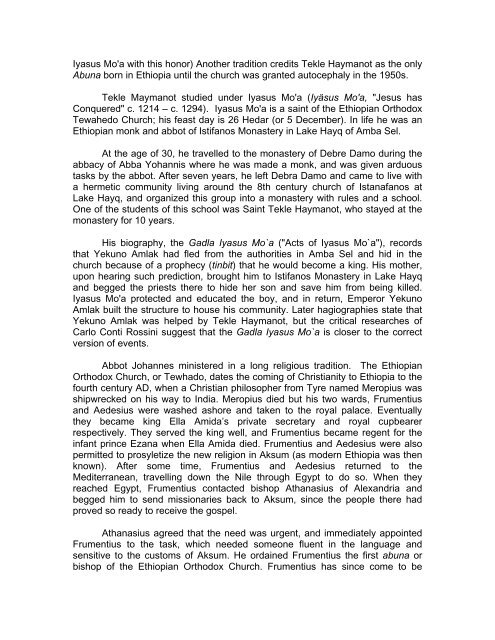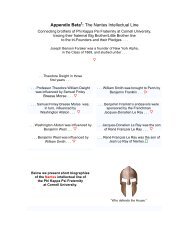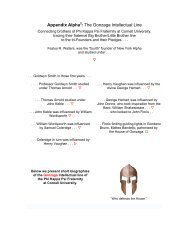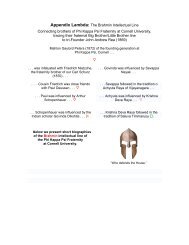Gondar - Phi Kappa Psi
Gondar - Phi Kappa Psi
Gondar - Phi Kappa Psi
You also want an ePaper? Increase the reach of your titles
YUMPU automatically turns print PDFs into web optimized ePapers that Google loves.
Iyasus Mo'a with this honor) Another tradition credits Tekle Haymanot as the only<br />
Abuna born in Ethiopia until the church was granted autocephaly in the 1950s.<br />
Tekle Maymanot studied under Iyasus Mo'a (Iyäsus Mo'a, "Jesus has<br />
Conquered" c. 1214 – c. 1294). Iyasus Mo'a is a saint of the Ethiopian Orthodox<br />
Tewahedo Church; his feast day is 26 Hedar (or 5 December). In life he was an<br />
Ethiopian monk and abbot of Istifanos Monastery in Lake Hayq of Amba Sel.<br />
At the age of 30, he travelled to the monastery of Debre Damo during the<br />
abbacy of Abba Yohannis where he was made a monk, and was given arduous<br />
tasks by the abbot. After seven years, he left Debra Damo and came to live with<br />
a hermetic community living around the 8th century church of Istanafanos at<br />
Lake Hayq, and organized this group into a monastery with rules and a school.<br />
One of the students of this school was Saint Tekle Haymanot, who stayed at the<br />
monastery for 10 years.<br />
His biography, the Gadla Iyasus Mo`a ("Acts of Iyasus Mo`a"), records<br />
that Yekuno Amlak had fled from the authorities in Amba Sel and hid in the<br />
church because of a prophecy (tinbit) that he would become a king. His mother,<br />
upon hearing such prediction, brought him to Istifanos Monastery in Lake Hayq<br />
and begged the priests there to hide her son and save him from being killed.<br />
Iyasus Mo'a protected and educated the boy, and in return, Emperor Yekuno<br />
Amlak built the structure to house his community. Later hagiographies state that<br />
Yekuno Amlak was helped by Tekle Haymanot, but the critical researches of<br />
Carlo Conti Rossini suggest that the Gadla Iyasus Mo`a is closer to the correct<br />
version of events.<br />
Abbot Johannes ministered in a long religious tradition. The Ethiopian<br />
Orthodox Church, or Tewhado, dates the coming of Christianity to Ethiopia to the<br />
fourth century AD, when a Christian philosopher from Tyre named Meropius was<br />
shipwrecked on his way to India. Meropius died but his two wards, Frumentius<br />
and Aedesius were washed ashore and taken to the royal palace. Eventually<br />
they became king Ella Amida’s private secretary and royal cupbearer<br />
respectively. They served the king well, and Frumentius became regent for the<br />
infant prince Ezana when Ella Amida died. Frumentius and Aedesius were also<br />
permitted to prosyletize the new religion in Aksum (as modern Ethiopia was then<br />
known). After some time, Frumentius and Aedesius returned to the<br />
Mediterranean, travelling down the Nile through Egypt to do so. When they<br />
reached Egypt, Frumentius contacted bishop Athanasius of Alexandria and<br />
begged him to send missionaries back to Aksum, since the people there had<br />
proved so ready to receive the gospel.<br />
Athanasius agreed that the need was urgent, and immediately appointed<br />
Frumentius to the task, which needed someone fluent in the language and<br />
sensitive to the customs of Aksum. He ordained Frumentius the first abuna or<br />
bishop of the Ethiopian Orthodox Church. Frumentius has since come to be






